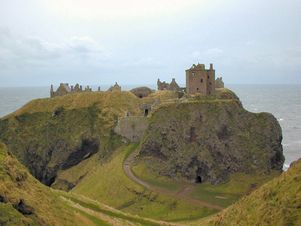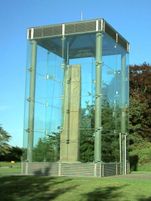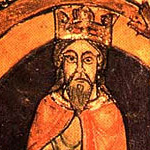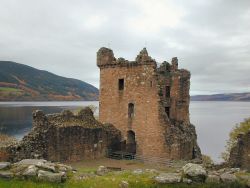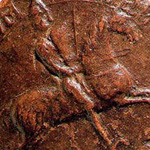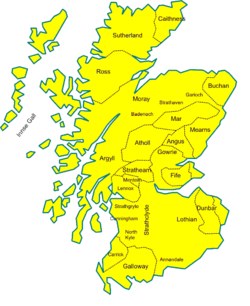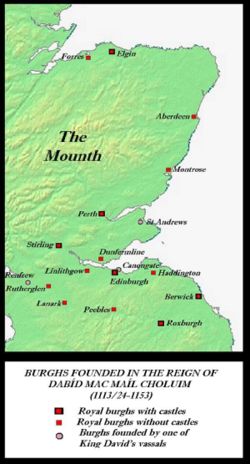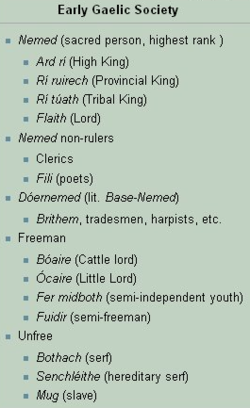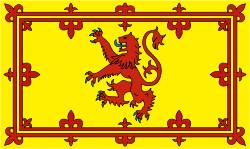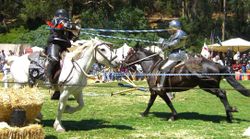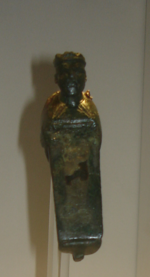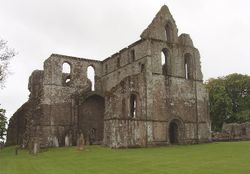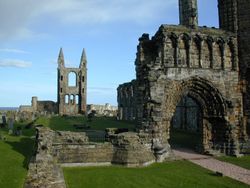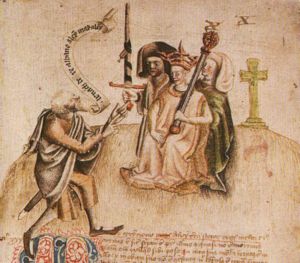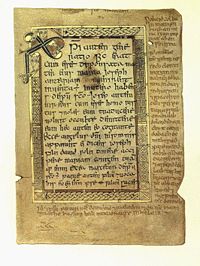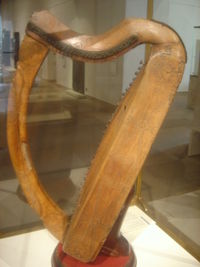Scotland in the High Middle Ages
2008/9 Schools Wikipedia Selection. Related subjects: British History 1500 and before (including Roman Britain)
The history of Scotland in the High Middle Ages covers Scotland in the era between the death of Domnall II in 900 AD and the death of king Alexander III in 1286, which led indirectly to the Scottish Wars of Independence.
In the tenth and eleventh centuries, northern Great Britain was increasingly dominated by Gaelic culture, and by a Gaelic regal lordship known in Gaelic as " Alba", in Latin as either "Albania" or " Scotia", and in English as "Scotland". From a base in eastern Scotland north of the River Forth, the kingdom acquired control of the lands lying to the south. It had a flourishing culture, comprising part of the larger Gaelic-speaking world.
After the twelfth-century reign of King David I, the Scottish monarchs are better described as Scoto-Norman than Gaelic, preferring French culture to native Scottish culture. They fostered and attached themselves to a kind of Scottish "Norman Conquest". The consequence was the spread of French institutions and social values. Moreover, the first towns, called burghs, began in the same era, and as these burghs spread, so did the Middle English language. To a certain degree these developments were offset by the acquisition of the Norse-Gaelic west, and the Gaelicization of many of the great families of French and Anglo-French origin, so that the period closes with what has been called a "Gaelic revival", and an integrated Scottish national identity. Although there remained a great deal of continuity with the past, by 1286 these economic, institutional, cultural, religious and legal developments had brought Scotland closer to its neighbours in England and the Continent. By 1286 the Kingdom of Scotland had political boundaries that closely resemble those of modern Scotland.
| History of Scotland |
|---|
| Chronological Eras |
| Prehistoric Scotland |
| Scotland in the Early Middle Ages |
| Scotland in the High Middle Ages |
| Wars of Scottish Independence |
| Scotland in the Late Middle Ages |
| Scottish Reformation |
| Scotland in the Early Modern Era |
| Scottish Enlightenment |
| Scotland in the Modern Era |
| Dynasties and Regimes |
| House of Alpin (843–878) & (889–1040) |
| House of Moray (1040–1058) |
| House of Dunkeld (1058–1286) |
| House of Balliol (1292–1296) |
| House of Bruce (1306–1371) |
| House of Stuart (1371–1707) |
| Act of Union (1707) |
| Topical |
| Art history |
| Colonial history |
| Culture |
| Economic history |
| Historiography |
| Literary history |
| Military history |
| Politics |
| Timeline of Scottish history |
| Scottish portal |
Historiography
Scotland is relatively well-studied in this period. New works come out every year, and the field of Scottish medievalism is a vibrant and changing one. Scottish medievalists can generally be grouped into two categories: Celticists and Normanists. The former, such as David Dumville, Thomas Owen Clancy and Dauvit Broun, are interested in the native cultures of the country, and often have linguistic training in the Celtic languages. Normanists are concerned with the French and Anglo-French cultures as they were introduced to Scotland after the eleventh century. The most prominent of such scholars is G.W.S. Barrow, who has devoted his life to studying feudalism in Britain and Scotland in the High Middle Ages. The change-continuity debate that derives from this division is currently one of the most active topics of discussion. For much of the twentieth century, scholars tended to stress the cultural change that took place in Scotland in the Norman era. However, many scholars, for instance Cynthia Neville and Richard Oram, while not ignoring cultural changes, are arguing that continuity with the Gaelic past was just as, if not more, important.
Origins of the Kingdom of Alba
During the period of occupation by the Roman Empire, the province of Britannia formally ended at Hadrian's Wall. Between this wall and the Antonine Wall, the Romans fostered a series of buffer states separating the Roman-occupied territory from the territory of the Picts. The development of "Pictland" itself, according to the historical model developed by Peter Heather, was a natural response to Roman imperialism. Around 400 the buffer states became the Brythonic kingdoms of " The Old North", and by 900 the Kingdom of the Picts had developed into the Gaelic Kingdom of Alba.
In the tenth century, the Scottish elite began to develop a conquest myth to explain their Gaelicization, a myth often known as MacAlpin's Treason, in which Cináed mac Ailpín is supposed to have annihilated the Picts in one fell takeover. The earliest versions include the Life of St Cathróe of Metz and royal genealogies tracing their origin to Fergus Mór mac Eirc. In the reign of Máel Coluim III, the Duan Albanach formalised the myth in Gaelic poetic tradition. In the thirteenth and fourteenth centuries, these mythical traditions were incorporated into the documents now in the Poppleton Manuscript, and in the Declaration of Arbroath. They were believed in the early modern period, and beyond; even King James VI/I traced his origin to Fergus, saying, in his own words, that he was a "Monarch sprunge of Ferguse race".
However, modern historians are now beginning to reject this conceptualization of Scottish origins. No contemporary sources mention this conquest. Moreover, the Gaelicization of Pictland was a long process predating Cináed, and is evidenced by Gaelic-speaking Pictish rulers, Pictish royal patronage of Gaelic poets, Gaelic inscriptions, and Gaelic placenames. The term king of Alba, although only registered at the start of the tenth century, is possibly just a Gaelic translation of Pictland. The change of identity can perhaps be explained by the death of the Pictish language, but also important may be Causantín II's alleged Scoticisation of the "Pictish" Church and the trauma caused by Viking invasions, most strenuously felt in the Pictish Kingdom's heartland of Fortriu.
Outside of Alba, the Kingdom of Strathclyde on the valley of the river Clyde remained semi-independent, as did the Gaels of Argyll and the islands to the west (formerly Dál Riata). The south-east had been absorbed by the English Kingdom of Bernicia/Northumbria in the seventh century, and other Germanic invaders, the Norse, were beginning to incorporate much of the Western and Northern Isles, as well as the Caithness area. Galloway too was under strong Norse-Gaelic influence, but there was no one kingdom in that area.
Kingdom of Alba or Scotia
Gaelic kings: Domnall II to Alexander I

King Domnall II was the first man to have been called rí Alban (i.e. King of Alba) when he died at Dunnottar in 900 - this meant king of Britain or Scotland. All his predecessors bore the style of either King of the Picts or King of Fortriu. Such an apparent innovation in the Gaelic chronicles is occasionally taken to spell the birth of Scotland, but there is nothing special about his reign that might confirm this. Domnall had the nickname dásachtach. This simply meant a madman, or, in early Irish law, a man not in control of his functions and hence without legal culpability. In fact, the long reign (900–942/3) of Domnall's successor Causantín is more often regarded as the key to formation of the High Medieval Kingdom of Alba. Despite some setbacks, it was during his half-century reign that the Scots saw off any danger that the Vikings would expand their territory beyond the Western and Northern Isles and the Caithness area.
The period between the accession of Máel Coluim I and Máel Coluim II was marked by good relations with the Wessex rulers of England, intense internal dynastic disunity and, despite this, relatively successful expansionary policies. In 945, king Máel Coluim I received Strathclyde as part of a deal with King Edmund of England, an event offset somewhat by Máel Coluim's loss of control in Moray. Sometime in the reign of king Idulb (954–962), the Scots captured the fortress called oppidum Eden, i.e. Edinburgh. Scottish control of Lothian was strengthened with Máel Coluim II's victory over the Northumbrians at the Battle of Carham (1018). The Scots had probably had some authority in Strathclyde since the later part of the ninth century, but the kingdom kept its own rulers, and it is not clear that the Scots were always strong enough to enforce their authority.
The reign of King Donnchad I from 1034 was marred by failed military adventures, and he was defeated and killed by the Mormaer of Moray, Mac Bethad mac Findláich, who became king in 1040. Mac Bethad ruled for seventeen years, so peacefully that he was able to leave to go on pilgrimage to Rome. However, he was overthrown by Máel Coluim, the son of Donnchad who eighteen months later defeated Mac Bethad's successor Lulach to become king Máel Coluim III. In subsequent medieval propaganda Donnchad's reign was portrayed positively, while Mac Bethad was vilified. William Shakespeare followed this distorted history in describing both men in his play Macbeth.

It was Máel Coluim III, not his father Donnchad, who did more to create the dynasty that ruled Scotland for the following two centuries, successfully compared to some. Part of the resource was the large number of children he had, perhaps as many as a dozen, through marriage to the widow or daughter of Thorfinn Sigurdsson, Earl of Orkney and afterwards to the Anglo-Hungarian princess Margaret, granddaughter of Edmund Ironside. However, despite having a royal Anglo-Saxon wife, Máel Coluim spent much of his reign conducting slave raids against the English, adding to the woes of that people in the aftermath of the Norman Conquest of England and the Harrying of the North. Marianus Scotus tells us that "the Gaels and French devastated the English; and [the English] were dispersed and died of hunger; and were compelled to eat human flesh".
Máel Coluim's raids and attempts to further the claims for his successors to the English kingdom prompted interference by the Norman rulers of England in the Scottish kingdom. He had married the sister of the native English claimant to the English throne, Edgar Ætheling, and had given most of his children by this marriage Anglo-Saxon royal names. In 1080, King William the Conqueror sent his son on an invasion of Scotland, and Máel Coluim submitted to the authority of the king, giving his oldest son Donnchad as a hostage. King Máel Coluim himself died in one of the raids, in 1093.
Tradition would have made his brother Domnall Bán Máel Coluim's successor, but it seems that Edward, his eldest son by Margaret, was his chosen heir. With Máel Coluim and Edward dead in the same battle, and his other sons in Scotland still young, Domnall was made king. However, Donnchad II, Máel Coluim's eldest son by his first wife, obtained some support from William Rufus and took the throne, but according to the Anglo-Saxon Chronicle his English and French followers were massacred, and Donnchad II himself was killed later in the same year (1094) by Domnall's ally Máel Petair of Mearns. However, in 1097, William Rufus sent another of Máel Coluim's sons, Edgar, to take the kingship. The ensuing death of Domnall Bán secured the kingship for Edgar, and there followed a period of relative peace. The reigns of both Edgar and his successor Alexander are obscure in comparison with their successors. The former's most notable act was to send a camel (or perhaps an elephant) to his fellow Gael Muircheartach Ua Briain, High King of Ireland. When Edgar died, Alexander took the kingship, while his youngest brother David became Prince of "Cumbria" and ruler of Lothian.
Scoto-Norman kings: David I to Alexander III
The period between the accession of David I and the death of Alexander III was marked by dependency upon and relatively good relations with the Kings of the English. As long as one remembers the continuities, the period can also be regarded as one of great historical transformation, part of a more general phenomenon which has been called the "Europeanisation of Europe". As a related matter, the period witnessed the successful imposition of royal authority across most of the modern country. After David I, and especially in the reign of William I, Scotland's Kings became ambivalent about the culture of most of their subjects. As Walter of Coventry tells us that "The modern kings of Scotland count themselves as Frenchmen, in race, manners, language and culture; they keep only Frenchmen in their household and following, and have reduced the Scots [=Gaels] to utter servitude."
The ambivalence of the kings was matched to a certain extent by the Scots themselves. In the aftermath of William's capture at Alnwick in 1174, the Scots turned on the small number of Middle English-speakers and French-speakers among them. William of Newburgh related that the Scots first attacked the Scoto-English in their own army, and Newburgh reported a repetition of these events in Scotland itself. Walter Bower, writing a few centuries later albeit, wrote about the same events, and confirms that "there took place a most wretched and widespread persecution of the English both in Scotland and Galloway".
Opposition to the Scottish kings in this period was indeed hard. The first instance is perhaps the revolt of Óengus, the Mormaer of Moray. Other important resistors to the expansionary Scottish kings were Somairle mac Gillai Brigte, Fergus of Galloway, Gille Brigte, Lord of Galloway and Harald Maddadsson, along with two kin-groups known today as the MacHeths and the MacWilliams. The latter claimed descent from king Donnchad II, through his son William fitz Duncan. The MacWilliams appear to have rebelled for no less a reason than the Scottish throne itself. The threat was so grave that, after the defeat of the MacWilliams in 1230, the Scottish crown ordered the public execution of the infant girl who happened to be the last of the MacWilliam line. This was how the Lanercost Chronicle related the fate of this last MacWilliam:
| “ | the same Mac-William's daughter, who had not long left her mother's womb, innocent as she was, was put to death, in the burgh of Forfar, in view of the market place, after a proclamation by the public crier. Her head was struck against the column of the market cross, and her brains dashed out. | ” |
Many of these resistors collaborated, and drew support not just in the peripheral Gaelic regions of Galloway, Moray, Ross and Argyll, but also from eastern "Scotland-proper", and elsewhere in the Gaelic world. However, by the end of the twelfth century, the Scottish kings had acquired the authority and ability to draw in native Gaelic lords outside their previous zone of control in order to do their work, the most famous examples being Lochlann, Lord of Galloway and Ferchar mac in tSagairt. Cumulatively, by the reign of Alexander III, the Scots were in a strong position to annex the remainder of the western seaboard, which they did in 1265, with the Treaty of Perth. The conquest of the west, the creation of the Mormaerdom of Carrick in 1186 and the absorption of the Lordship of Galloway after the Galwegian revolt of Gille Ruadh in 1235 meant that the number and proportion of Gaelic speakers under the rule of the Scottish king actually increased, and perhaps even doubled, in the so-called Norman period. It was the Gaels and Gaelicised warriors of the new west, and the power they offered, that enabled King Robert I (himself a Gaelicised Scoto-Norman of Carrick) to emerge victorious during the Wars of Independence, which followed soon after the death of Alexander III.
Other Kingdoms
Amidst the genre of National histories and the scholarly desire to explain and legitimise modern national entities, it is easy to forget that the Kingdom of Alba was not the only source of regal authority in northern Britain. In fact, until the Norman era, and perhaps even until the reign of Alexander II, the Scottish king controlled only a minority of the people who lived inside the boundary of modern Scotland, in the same way as the French monarchs of the Middle Ages only had control of patches of what is now modern France. The ruler of Moray was called not only king in both Scandinavian and Irish sources, but before Máel Snechtai, king of Alba/Scotland. After Máel Snechtai, Irish sources call them merely kings of Moray. The rulers of Moray in fact took over the entire Scottish kingdom in 1040, under the famous Mac Bethad mac Findláich (1040–1057) and his successor Lulach mac Gillai Choemgáin (1057–1058). However, Moray was subjugated by the Scottish kings after 1130, when the last native ruler, Óengus of Moray was defeated in an attempt to seize the Scottish throne.
Galloway, likewise, was a Lordship with some regality. In a Galwegian charter dated to the reign of Fergus, the Galwegian ruler styled himself rex Galwitensium, King of Galloway. We know that Irish chroniclers continued to call Fergus' successors King. Although the Scots obtained greater control after the death of Gilla Brigte and the installation of Lochlann/Roland in 1185, Galloway was not in fact fully absorbed by Scotland until 1235, after the rebellion of the Galwegians was crushed.
Galloway and Moray were not the only other territories whose rulers had regal status. Both the rulers of Mann & the Isles, and the rulers of Argyll had the status of kings, even if some southern Latin writers called them merely reguli (i.e. "kinglets"). The Mormaers of Lennox referred to their predecessors as Kings of Balloch, and indeed many of the Mormaerdoms had been kingdoms at an earlier stage. Another kingdom, Strathclyde (or Cumbria), had been incorporated into Scotland in a slow process that started in the ninth century and was not fully realized until perhaps the twelfth.
Geography
Neither the political nor the theoretical boundaries of Scotland in this period, as both Alba and Scotia, corresponded exactly to modern Scotland. The closest approximation came at the end of the period, when the Treaty of York (1237) and Treaty of Perth (1266) fixed the boundaries between the Kingdom of the Scots with England and Norway respectively; although in neither case did this border exactly match the modern one, Berwick and the Isle of Man being eventually lost to England, and Orkney and Shetland later being gained from Norway.
Until the thirteenth century, Scotland referred to the land to the north of the river Forth, and for this reason historians sometimes use the term "Scotland-proper". By the middle of the thirteenth century, Scotland could include all the lands ruled by the King of Scots, but the older concept of Scotland remained throughout the period.
For legal and administrative purposes, the Kingdom of the Scots was divided into three, four or five zones: Scotland-proper (north and south of the Grampians), Lothian, Galloway and, earlier, Strathclyde. Like Scotland, neither Lothian nor Galloway had its modern meaning. Lothian could refer to the entire Middle English-speaking south-east, and latterly, included much of Strathclyde. Galloway could refer to the entire Gaelic-speaking south-west. Lothian was divided from Scotland-proper by the river Forth. To quote the early thirteenth century tract, de Situ Albanie,
| “ | the excellent piece of water that is called in Scottish the 'Froth', in British the 'Werid', and in Romance the 'Scottewatre' that is, the Water of the Scots, which divides the kingdoms of the Scots and of the English, and runs near the town of Stirling. | ” |
Here Scottish refers to the language now called the Middle Irish language, British to the Welsh language and Romance to the Old French language, which had borrowed the term Scottewatre from the Middle English language.
In this period, little of Scotland was governed by the crown. Instead, most Scots lay under the intermediate control of Gaelic and increasingly after the twelfth century, French-speaking Mormaers/Earls and Lords.
Economy
The Scottish economy of this period was dominated by agriculture and by short-distance, local trade. There was an increasing amount of foreign trade in the period, as well as exchange gained by means of military plunder. By the end of this period, coins were replacing barter goods, but for most of this period most exchange was done without the use of metal currency.
Most of Scotland's agricultural wealth in this period came from pastoralism, rather than arable farming. Arable farming grew significantly in the "Norman period", but with geographical differences, low-lying areas being subject to more arable farming than high-lying areas such as the Highlands, Galloway and the Southern Uplands. Galloway, in the words of G.W.S. Barrow, "already famous for its cattle, was so overwhelmingly pastoral, that there is little evidence in that region of land under any permanent cultivation, save along the Solway coast." The average amount of land used by a husbandman in Scotland might have been around 26 acres. There is a lot of evidence that the native Scots favoured pastoralism, in that Gaelic lords were happier to give away more land to French and Middle English-speaking settlers, whilst holding on tenaciously to more high-lying regions, perhaps contributing to the Highland/Galloway-Lowland division that emerged in Scotland in the later Middle Ages. The main unit of land measurement in Scotland was the davoch (i.e. "vat"), called the arachor in Lennox. This unit is also known as the "Scottish ploughgate." In English-speaking Lothian, it was simply ploughgate. It may have measured about 104 acres, divided into 4 raths. Cattle, pigs and cheeses were among the most produced foodstuffs, but of course a vast range of foodstuffs were produced, from sheep and fish, rye and barley, to bee wax and honey.
Pre-Davidian Scotland had no towns. The closest thing to towns were the larger than average population concentrations around large monasteries, such as Dunkeld and St Andrews, and regionally significant fortifications. Scotland, outside Lothian at least, was populated by scattered hamlets, and outside that area, lacked the continental style nucleated village. David I established the first burghs in Scotland, initially only in English-speaking Lothian. David I copied the burgher charters and Leges Burgorum (rules governing virtually every aspect of life and work in a burgh) almost verbatim from the English customs of Newcastle-Upon-Tyne. Early burgesses were usually Flemish, English, French and German, rather than Gaelic Scots. The burgh’s vocabulary was composed totally of either Germanic and French terms. The councils which ran individual burghs were individually known as lie doussane, meaning the dozen.
Demographics
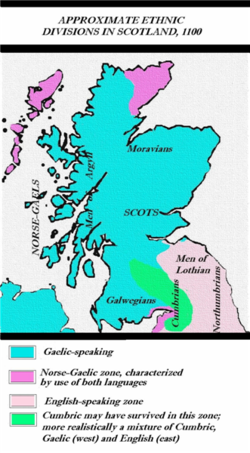
The population of Scotland in this period is unknown. Not until 1755 do we get reliable information about the population of Scotland, when it was 1,265,380. However, best estimates put the Scottish population in this period between 500,000 and 1,000,000 people, growing from a low point to a high point. This population was much more evenly spread than today. We can estimate that between 60 and 80% of people lived north of the Forth river, with the remainder being divided between Galloway, Strathclyde and Lothian. Bishopric and Justiciar distribution suggests a relatively even divide between these three zones.
Linguistically, the vast majority of people within Scotland throughout this period spoke the Gaelic language, then simply called Scottish, or in Latin, lingua Scotica. Other languages spoken throughout this period were Norse and English, with the Cumbric language disappearing somewhere between 900 and 1100. Pictish may have survived into this period, but there is little evidence for this. After the accession of David I, or perhaps before, Gaelic ceased to be the main language of the royal court. From his reign until the end of the period, the Scottish monarchs probably favoured the French language, as evidenced by reports from contemporary chronicles, literature and translations of administrative documents into the French language. English, with French and Flemish, became the main language of Scottish towns ( burghs), which were created for the first time under David I. However, burghs were, in Barrow's words, “scarcely more than villages … numbered in hundreds rather than thousands”, and Norman knights were a similarly tiny in number when compared with the Gaelic population of Scotland outside of Lothian.
Society
Medieval Scottish society was stratified. We know more about status in early Gaelic society than perhaps any other early medieval European society, owing primarily to the large body of legal texts and tracts on status which are extant. The legal tract that has come down to us as the Laws of Brets and Scots, lists five grades of man: King, mormaer/ earl, toísech/thane, ócthigern and serf. For pre-twelfth century Scotland, we should add slave to this category. The standard differentiation in medieval European society between the bellatores ("those who fight", i.e. aristocrats), the oratores ("those who pray", i.e. clergy) and the laboratores ("those who work", i.e. peasants) was useless for understanding Scottish society in the earlier period, but becomes more useful in the post-Davidian period.
Most of the territory subject to the King of Scots north of the Forth was directly under a lord who in medieval Scottish was called a Mormaer. The term was translated into Latin as comes, and is misleadingly translated into modern English as Earl. These secular lords exercised secular power and religious patronage like kings in miniature. They kept their own warbands and followers, issued charters and supervised law and internal order within their provinces. When actually under the power of the Scottish king, they were responsible for rendering to the king cain, a tribute paid several times a year, usually in cattle and other barter goods. They also had to provide for the king conveth, a kind of hospitality payment, paid by putting-up the lord on a visit with food and accommodation, or with barter payments in lieu of this. In the Norman era, they provided the servitum Scoticanum ("Gaelic service", "Scottish service" or simply forinsec) and led the exercitus Scoticanus , the Gaelic part of the king's army that made up the vast majority almost any national hosting (slógad) in the period.
A toísech ("chieftain") was like a mormaer, providing for his lord the same services that a mormaer provided for the king. The Latin word usually used is thanus, which is why the office-bearers are often called "thanes" in English. The formalization of this institution was largely confined to eastern Scotland north of the Forth, and only two of the seventy-one known thanages existed south of that river. Behind the offices of toísech and mormaer were kinship groups. Sometimes these offices were formalized, but mostly they are informal. The head of the kinship group was called capitalis in Latin and cenn in medieval Gaelic. In the Mormaerdom of Fife, the primary kinship group was known then as Clann MacDuib ("Children of MacDuff"). Others include the Cennedig (from Carrick), Morggain (from Buchan), and the MacDowalls (from Galloway). There were probably hundreds in total, mostly unrecorded.
The highest non-noble rank was, according to the Laws of Brets and Scots, called the ócthigern (literally, little or young lord), a term the text does not bother to translate into French. The Anglo-Saxon equivalent was perhaps the sokeman. Other known ranks include the scoloc, perhaps equivalent to the Anglo-Saxon gerseman. In the earlier period, the Scots kept slaves, and many of these were foreigners (English or Scandinavian) captured during warfare. Large-scale Scottish slave-raids are particularly well documented in the eleventh century.
Law and government
Early Gaelic law tracts, first written down in the ninth century, reveal a society highly concerned with kinship, status, honour and the regulation of blood feuds. Scottish common law began to take shape at the end of the period, assimilating Gaelic and Celtic law with practices from Anglo-Norman England and the Continent. In the twelfth century, and certainly in the thirteenth, strong continental legal influences began to have more effect, such as Canon law and various Anglo-Norman practices. Pre-fourteenth century law amongst the native Scots is not always well attested. However, our extensive knowledge of early Gaelic Law gives some basis for reconstructing pre-fourteenth century Scottish law. In the earliest extant Scottish legal manuscript, there is a document called Leges inter Brettos et Scottos. The document survives in Old French, and is almost certainly a French translation of an earlier Gaelic document. The document retained untranslated a vast number of Gaelic legal terms. Later medieval legal documents, written both in Latin and Middle English, contain more Gaelic legal terms, examples including slains (Old Irish slán or sláinte; exemption) and cumherba (Old Irish comarba; ecclesiastic heir).
A Judex (pl. judices) represents a post-Norman continuity with the ancient Gaelic orders of lawmen called in English today Brehons. Bearers of the office almost always have Gaelic names north of the Forth or in the south-west. Judices were often royal officials who supervised baronial, abbatial and other lower-ranking "courts". However, the main official of law in the post-Davidian Kingdom of the Scots was the Justiciar. The institution has Anglo-Norman origins, but in Scotland north of the Forth it probably represented some form of continuity with an older office. For instance, Mormaer Causantín of Fife is styled judex magnus (i.e. great Brehon), and it seems that the Justiciarship of Scotia was just a further Latinisation/Normanisation of that position. The formalized office of the Justiciar held responsibility for supervising the activity and behaviour of royal sheriffs and sergeants, held courts and reported on these things to the king personally. Normally, there were two Justiciarships, organized by linguistic boundaries: the Justiciar of Scotia and the Justiciar of Lothian. Sometimes Galloway had its own Justiciar too.
The office of Justiciar and Judex were just two ways that Scottish society was governed. In the earlier period, the king "delegated" power to hereditary native "officers" such as the Mormaers/Earls and Toísechs/Thanes. It was a government of gift-giving and bardic lawmen. There were also popular courts, the comhdhail, testament to which are dozens of placenames throughout eastern Scotland. In the Norman period, sheriffdoms and sherrifs and, to a lesser extent, bishops (see below) became increasingly important. The former enabled the King to effectively administer royal demesne land. During David I's reign, royal sheriffs had been established in the king's core personal territories; namely, in rough chronological order, at Roxburgh, Scone, Berwick-upon-Tweed, Stirling and Perth. By the reign of William I, there may have been about 30 royal sheriffdoms, including ones at Ayr and Dumfries, key locations on the borders of Galloway- Carrick. As the distribution and number of sheriffdoms expanded, so did royal control. By the end of the thirteenth century, sheriffdoms had been established in westerly locations as far-flung as Wigtown, Kintyre, Skye and Lorne. Through these, the thirteenth century Scottish king exercised more control over Scotland than any of his later medieval successors. The king himself was itinerant and had no "capital"; but if there was such a thing, it was Scone. By ritual tradition, all Scottish kings in this period had to be crowned there, and crowned there by the Mormaers of Strathearn and, especially, Fife. Although King David I tried to build up Roxburgh as a capital, in the twelfth and thirteenth centuries, more charters were issued at Scone than any other location. Other popular locations were nearby Perth, Stirling, Dunfermline and Edinburgh (especially popular during the reign of Alexander II), as well as all other royal burghs. In the earliest part of this era, Forres and Dunkeld seem to have been the chief royal residences.
Military
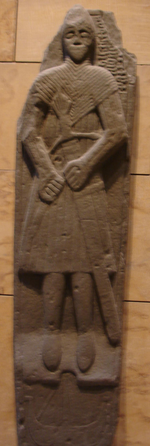
After the "Norman Conquest" of David I, the warriors of Scotland can be classed as of two types. Firstly, the native exercitus Scoticanus (i.e. "Gaelic army"); and, secondly, the exercitus militaris (i.e. "feudal army"). The Gaelic army formed the larger part of all pre-Stewart Scottish armies, but in the wider world of European (i.e. French) chivalry the feudal section was the more prestigious. The native Scots, like all early medieval Europeans, practiced organized slave-raiding. Presumably, they did so with each other. However, our main record of it comes from when they practised it against their Norman and post-Conquest Anglo-Saxon neighbour. John Gillingham argues that this was one of the things which made the Scots (and other Celts) particularly barbarous in the eyes of their "Frankish" neighbours, because the French had largely abandoned this form of warfare.
As with so many changes in this period, the introduction of the feudal army can be traced primarily to the reign of David I, although French and English knights were used in moderation by his older brothers. The tension which these knights produced is well recorded in contemporary sources. At the Battle of the Standard, the Gaels oppose the positioning of the French soldiers in the van of the king's army. Ailred of Rievaulx attributes this opposition to the Galwegians, but we know it was the Scottish Gaels in general, as the native spokesman is given as Máel Ísu, then the Mormaer of Strathearn and highest ranking noble in the army.
The advantage French military culture possessed was manifold. French knights used expensive suits of armour, whereas the Scots were "naked" (of armour, rather than dress). They possessed heavy cavalry, and other weapons such as crossbows and siege engines, as well as fortification techniques far more effective and advanced than anything possessed by the native Scots. Moreover, their culture, particularly their feudal ideology, made them reliable vassals, who because they were foreign, were even more dependent on the king. Over time, the Scots themselves became more like the French warriors, and the French warriors adopted many of the Gaelic military practices, so that by the end of the period, a syncretic military culture existed in the kingdom. When the feudal army was destroyed at the Battle of Dunbar (1296), the Scots were dependent once again on the Gaelic army. However, owing to two centuries of adaptation and the leadership of the Gaelic-speaking Scoto-Norman Robert Bruce, this army was able to defeat the attempted takeover by the English-crown.
Christianity and the Church
We can be sure that at least all of northern Britain, except the Scandinavian far north and west was Christian by the tenth century. The most important factors for the conversion of Scotland were the Roman province of Britannia to the south, and later the so-called Gaelic or Columban church, an interlinked system of monasteries and aristocratic networks which combined to spread both Christianity and the Gaelic language amongst the Picts.
Saints
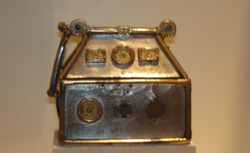
Like every other Christian country, one of the main features of Scottish Christianity is the Cult of Saints. Saints were the middle men between the ordinary worshipper and God. In Scotland north of the Forth, local saints were either Pictish or Gaelic. The national saint of the Scottish Gaels was Colum Cille or Columba (in Latin, lit. dove), in Strathclyde it was St Kentigern (in Gaelic, lit. Chief of the Lord), in Lothian, St Cuthbert. Later, owing to learned confusion between the Latin words Scotia and Scythia, the Scottish kings adopted St Andrew, a saint who had more appeal to incoming Normans and was attached to the ambitious bishopric that is now known by the saint's name, St Andrews. However, Columba's status was still supreme in the early fourteenth century, when King Robert I carried the brecbennoch (or Monymusk reliquary) into battle at Bannockburn. Around the same period, a cleric on Inchcolm wrote the following Latin poem:
| Latin | English |
| Os mutorum, lux cecorum, |
Mouth of the dumb [people], light of the blind [people] |
The poem illustrates both the role of saints, in this case as the representative of the Scottish (or perhaps just Gaelic) people in heaven, and the importance of Columba to the Scottish people.
Monasticism
The typical features of native Scottish Christianity are relaxed ideas of clerical celibacy, intense secularization of ecclesiastical institutions, and the lack of a dioscesan structure. Instead of bishops and archbishops, the most important offices of the native Scottish church were abbots (or coarbs). Scotland was untouched by continental forms of monasticism until the late eleventh century. Instead, monasticism was dominated by monks called Céli Dé (lit. "vassals of God"), anglicised as culdees. In most cases, these monks were not replaced by new continental monks in the Norman period, but usually survived, even gaining the patronage of Queen Margaret, a figure traditionally seen as hostile to Gaelic culture. At St Andrews, the Céli Dé establishment endured throughout the period, and even enjoyed rights over the election of its bishop. In fact, Gaelic monasticism was vibrant and expansionary for much of the period. For instance, dozens of monasteries, often called Schottenklöster, were founded by Gaelic monks on the continent, and many Scottish monks, such as St Cathróe of Metz, became local saints.
The continental type of monasticism was first introduced to Scotland when King Máel Coluim III persuaded Lanfranc to provide a few monks from Canterbury for a new Benedictine abbey at Dunfermline (c. 1070). However, traditional Benedictine monasticism had little future in Scotland. Instead, the monastic establishments which followed were almost universally either Augustinians or of the Reformed Benedictine type, especially Cistercians, Tironensians, Premonstratensians and evens Valliscaulians.
Ecclesia Scoticana
The Ecclesia Scoticana (lit. Scottish church) as a system has no known starting point, although Causantín II's alleged Scoticisation of the "Pictish" Church might be taken as one. Before the Norman period, Scotland had little dioscesan structure, being primarily monastic after the fashion of Ireland. After the Norman Conquest of England, the Archbishops of both Canterbury and York each claimed superiority over the Scottish church. The church in Scotland attained independent status after the Papal Bull of Celestine III (Cum universi, 1192) by which all Scottish bishoprics except Galloway were formally independent of York and Canterbury. However, unlike Ireland which had been granted four Archbishoprics in the same century, Scotland received no Archbishop and the whole Ecclesia Scoticana, with individual Scottish bishoprics (except Whithorn/Galloway), became the "special daughter of Rome". The following is a table of Bishoprics present in "Scotland-proper" in the thirteenth century:
|
Outside of Scotland-proper, the bishopric of Glasgow managed to secure its existence in the twelfth century with a vibrant church community who gained the favour of the Scottish kings. The Bishopric of Whithorn (Galloway) was resurrected by Fergus, King of Galloway, and Thurstan, Archbishop of York. The bishopric of the isles, under the nominal jurisdiction of Trondheim (and sometimes York), had its Episcopal seat at Peel, Isle of Man, later moving to Iona. Lothian had no bishop, but was controlled by St Andrews, Dunkeld and Glasgow. Its natural overlord was the Bishopric of Durham, and that bishopric continued to be important in Lothian, especially through the cult of St Cuthbert. There was also a bishopric of Orkney, based at Kirkwall.
Culture
As a predominantly Gaelic society, most Scottish cultural practices throughout this period mirrored closely those of Ireland, or at least those of Ireland with some Pictish borrowings. After David I, the French-speaking kings introduced cultural practices popular in Anglo-Norman England, France and elsewhere. As in all pre-modern societies, storytelling was popular. In the words of D.D.R. Owen, a scholar who specialises in the literature of the era, writes that "Professional storytellers would ply their trade from court to court. Some of them would have been native Scots, no doubt offering legends from the ancient Celtic past performed ... in Gaelic when appropriate, but in French for most of the new nobility" Almost all of these stories are lost, or come down only vaguely in Gaelic or Scots oral tradition. One form of oral culture extremely well accounted for in this period is genealogy. There are dozens of Scottish genealogies surviving from this era, covering everyone from the Mormaers of Lennox and Moray, to the Scottish king himself. Scotland's kings maintained an ollamh righe, a royal high poet who had a permanent place in all medieval Gaelic lordships, and whose purpose was to recite genealogies when needed, for occasions such as coronations.
Before the reign of David I, the Scots possessed a flourishing literary elite who regularly produced texts in both Gaelic and Latin that were frequently transmitted to Ireland and elsewhere. Dauvit Broun has shown that a Gaelic literary elite survived in the eastern Scottish lowlands, in places such as Loch Leven and Brechin into the thirteenth century, However, the records which have come down to us are predominantly written in Latin, and their authors would usually translate vernacular terms into Latin, so that historians are faced with a Gaelic society clothed in Latin terminology. Even names were translated into more common continental forms; for instance, Gilla Brigte became Gilbert, Áed became Hugh, etc. As far as written literature is concerned, there may be more medieval Scottish Gaelic literature than is often thought. Almost all medieval Gaelic literature has survived because it was allowed to sustain in Ireland, not in Scotland. Thomas Owen Clancy has recently all but proven that the Lebor Bretnach, the so-called "Irish Nennius," was written in Scotland, and probably at the monastery in Abernethy. Yet this text survives only from manuscripts preserved in Ireland. Other literary work which has survived include that of the prolific poet Gille Brighde Albanach. About 1218, Gille Brighde wrote a poem — Heading for Damietta — on his experiences of the Fifth Crusade. In the thirteenth century, French flourished as a literary language, and produced the Roman de Fergus, the earliest piece of non-Celtic vernacular literature to survive from Scotland. There is no extant literature in the English language in this era. There is some Norse literature from Scandinavian parts, such as the Northern Isles and the Western Isles. The famous Orkneyinga Saga however, although it pertains to the Earldom of Orkney, was written in Iceland.
In the Middle Ages, Scotland, was renowned for its musical skill. Gerald of Wales tells us that:
|
"Scotland, because of her affinity and intercourse [with Ireland], tries to imitate Ireland in music and strives in emulation. Ireland uses and delights in two instruments only, the harp namely, and the tympanum. Scotland uses three, the harp, the tympanum and the crowd. In the opinion, however, of many, Scotland has by now not only caught up on Ireland, her instructor, but already far outdistances her and excels her in musical skill. Therefore, [Irish] people now look to that country as the fountain of the art." |
The medieval Scots indeed took harping very seriously. We know that, even half a century after Gerald was writing, King Alexander III kept a royal harpist. Of the three mediaeval harps that survive, two come from Scotland (Perthshire), and one from Ireland. Singers also had a royal function. For instance, when the king of Scotland passed through the territory of Strathearn, it was the custom that he be greeted by seven female singers, who would sing to him. When Edward I approached the borders of Strathearn in the summer of 1296, he was met by these seven women, "who accompanied the King on the road between Gask and Ogilvie, singing to him, as was the custom in the time of the late Alexander kings of Scots".
Outsiders' view
The Irish thought of Scotland as a provincial place. Others thought of it as an outlandish or barbaric place. To the Holy Roman Emperor Friedrich II, Scotland was associated with having many lakes; to the Arabs, it was an uninhabited peninsula to the north of England.
"Who would deny that the Scots are barbarians?" was a rhetorical question posed by the author of the De expugnatione Lyxbonensi (i.e. "On the Conquest of Lisbon"). A century later St Louis of France was reported to have said to his son “I would prefer that a Scot should come from Scotland and govern the people well and faithfully, than that you, my son, should be seen to govern badly”. To their English-speaking and French-speaking neighbours, the Scots, especially the Galwegians, became the barbarians par excellence. After David I this ceased to be applied to their rulers, but the term barbarus was used to describe the Scots, as well as a large number of other European peoples, throughout the High Middle Ages. This characterisation of the Scots was often politically motivated, and many of the most hostile writers were based in areas frequently subjected to Scottish raids. English and French accounts of the Battle of the Standard contain many accounts of Scottish atrocities. For instance, Henry of Huntingdon tells us that the Scots:
| “ | cleft open pregnant women, and took out the unborn babes; they tossed children upon the spear-points, and beheaded priests on altars: they cut the head of crucifixes, and placed them on the trunks of the slain; and placed the heads of the dead upon the crucifixes. Thus wherever the Scots arrived, all was full of horror and full of savagery. | ” |
A less hostile view was given by Guibert of Nogent in the First Crusade, who encountered Scots and who wrote that:
| “ | You might have seen a crowd of Scots, a people savage at home but unwarlike elsewhere, descend from their marshy lands, with bare legs, shaggy cloaks, their purse hanging from their shoulders; their copious arms seemed ridiculous to us, but they offered their faith and devotion as aid. | ” |
In many ways, these accounts tell us merely that in the Frankish cultural milieu, the Scots were seen as outsiders. Moreover, the fact that outlandishness did not apply to the new feudal elite meant that by the end of the period, the Scottish aristocrat was seen as little different from his English or French equivalent.
There was a general belief that Scotland-proper was an island, or at least a peninsula, known as Scotia, Alba(nia), or, in the map of Matthew Paris, called Scotia ultra marina. In fact, it was in this manner that the land was drawn in the mid-thirteenth century by the aforementioned Matthew Paris. A later medieval Italian map applies this geographical conceptualization to all of Scotland. The Arab geographer al-Idrisi, shared this view. He tells us that Scotland:
| “ | adjoins the island of England and is a long peninsula to the north of the larger island. it is uninhabited and has neither town nor village. Its length is 150 miles. | ” |
Such an observation encapsulates how Scotland, on the edge of the world as it was, was being imagined in the High Medieval western Eurasian world.
National identity
In this period, the word Scot was not the word used by vast majority of Scots to describe themselves. This was in fact only the word they used to describe themselves to foreigners, amongst whom it was the most common word. The Scots called themselves Albanach or simply Gaidel. As with Scot, in the latter word, they used an ethnic term which connected them to the majority of the inhabitants of Ireland. As the author of De Situ Albanie tells us at the beginning of the thirteenth century:
|
"The name Arregathel [=Argyll] means margin of the Scots or Irish, because all Scots and Irish are generally called "Gattheli"" |
Likewise, the inhabitants of English and Norse-speaking parts were ethnically linked with other regions of Europe. At Melrose, people could recite religious literature in the English language. In the later part of the twelfth century, the Lothian writer Adam of Dryburgh, tells us that Lothian was “the Land of the English in the Kingdom of the Scots”.
However, despite Scotland's large ethnic variety, it came to possess a unity which eventually transcended Gaelic, French and Germanic ethnic differences. By the end of our period, the Latin, French and English word Scot could be used for any subject of the Scottish King. Scotland's multilingual Scoto-Norman monarchs and mixed Gaelic and Scoto-Norman aristocracy all became part of what many scholars call the "Community of the Realm", although ethnic differences (particularly between Scots (English) -speaking lowlanders and Gaelic-speaking highlanders) were not to be forgotten for many years.
